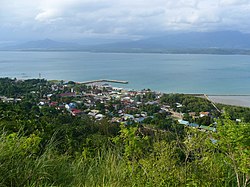Calubian | |
|---|---|
| Municipality of Calubian | |
 Hilltop view of Calubian | |
 Map of Leyte with Calubian highlighted | |
 Interactive map of Calubian | |
Location within the Philippines | |
| Coordinates: 11°26′48″N124°25′40″E / 11.4467°N 124.4278°E | |
| Country | Philippines |
| Region | Eastern Visayas |
| Province | Leyte |
| District | 3rd district |
| Founded | January 8, 1919 |
| Barangays | 53 (see Barangays) |
| Government | |
| • Type | Sangguniang Bayan |
| • Mayor | Marciano A. Batiancela Jr. |
| • Vice Mayor | Bing Veloso |
| • Representative | Anna Victoria V. Tuazon |
| • Councilors | List |
| • Electorate | 25,058 voters (2025) |
| Area | |
• Total | 100.95 km2 (38.98 sq mi) |
| Elevation | 82 m (269 ft) |
| Highest elevation | 1,336 m (4,383 ft) |
| Lowest elevation | 0 m (0 ft) |
| Population (2024 census) [3] | |
• Total | 31,990 |
| • Density | 316.9/km2 (820.7/sq mi) |
| • Households | 8,670 |
| Economy | |
| • Income class | 4th municipal income class |
| • Poverty incidence | 31.47 |
| • Revenue | ₱ 171.5 million (2022) |
| • Assets | ₱ 367.1 million (2022) |
| • Expenditure | ₱ 134.6 million (2022) |
| • Liabilities | ₱ 150.8 million (2022) |
| Service provider | |
| • Electricity | Leyte 5 Electric Cooperative (LEYECO 5) |
| Time zone | UTC+8 (PST) |
| ZIP code | 6534 |
| PSGC | |
| IDD : area code | +63 (0)53 |
| Native languages | Cebuano Tagalog |
Calubian, officially the Municipality of Calubian (Waray : Bungto han Calubian; Cebuano : Lungsod sa Calubian; Tagalog : Bayan ng Calubian), is a municipality in the province of Leyte, Philippines. According to the 2020 census, it has a population of 31,646 people. [5]







